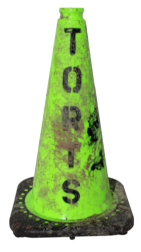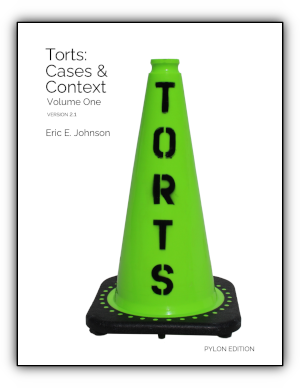
|
Torts: Cases & Context |

|
Torts: Cases & Context |
The 2.1 edition is updated and improved with notable usability enhancements, including coding for PDF sidebar navigation. Contact the author for a guide to changes. (As always, prior versions stay available.)
Professors: If you've adopted this book, please let me know! Because there are no sales or royalties, I can only measure impact by the adoptions I know about. E-mail me at eric.e.johnson@ou.edu.
Students: I'm happy to get your feedback! eric.e.johnson@ou.edu.
TC&C combines traditional casebook readings with straightforward, textbook-like explanations. The idea is that when students stop to puzzle over something, it should be because the law itself puzzles, not because the book obfuscates.
Students describe the book as easy to read. By being clear and straightforward, the casebook aims to quickly get students to the point where they can navigate regions of gray and build nuanced arguments.
Doctrine is explained upfront, before the cases. After cases, there's no notes-and-questions mishmash. Check-your-understanding questions, questions to ponder, historical notes, etc., are all organized under separate headings.
Readings mix classic cases with very recent ones, such as texting-and-driving and suddenly accelerating Toyotas. Varied primary sources include an opening statement, a closing argument, and an Navajo opinion on tribal law.
A key aim is context—showing how bits of doctrine fit into the bigger picture of tort law and how it all connects to the real world.
Also, this book is free! It costs no money to download, and you can get a print copy at cost. Also, the Creative Commons license ensures the freedom to abridge, expand, repurpose, or adapt the text.
Torts: Cases & Context was written by Eric E. Johnson (CV, bio) professor of law at the University of Oklahoma College of Law. Professor Johnson has taught torts for over a decade.
The Center for Computer Assisted Legal Instruction (CALI), a non-profit consortium of law schools, provided funding for the creation of the book.



Torts: Cases & Context is licensed under the Creative Commons Attribution-ShareAlike 4.0 License (CC-BY-SA 4.0).
This makes the book open source in addition to being free to access. Consistent with the terms of the Creative Commons license that this book is published under, generations of instructors and students will be able to rip and remix this book to suit their needs. This is because the license lets you change up and redistribute the book so long as you share it forward—that is, so long as you make it available to others under the same license.
The CC license is, in essence, a legal trick to keep downstream users from locking the book up with their own proprietary copyright claims.
Get the details here: CC-BY-SA 4.0.


A record of previous editions and versions may be found here.
I'm committed to zero retained author royalties/revenue for the distribution of Torts Cases & Context. The law-school consortium CALI generously gave me a grant for authoring the first edition. And as a professor I'm compensated as a university employee, of course. That said, I am not trying to make any money from TC&C's distribution or from sales of printed copies.
For many years, in making the book available through print-on-demand vendors, I was able to select "zero" as the revenue goal and avoid any revenues. These print-on-demand vendors are complicated. Lots of forms to fill out, options to select. But as of August 2025, it looks like selecting "zero" revenue for print-on-demand may not be possible in some circumstances. As a separate issue, I'd like to get information about how many copies are made and where they are shipped so that I can glean information on course adoptions and the usefulness of the book to students and teachers. To get that information, I might need to select some minimal amount of revenue (perhaps one cent?) in order to get reports from vendors.
At any rate, with glitchy interfaces and opaque requirements, I need more information. But to the extent I end up receiving any money from a print-on-demand vendor, I'll unload it by giving it to civil legal aid, law student financial assistance, or something similar.
And don't forget, you can always print the book yourself.